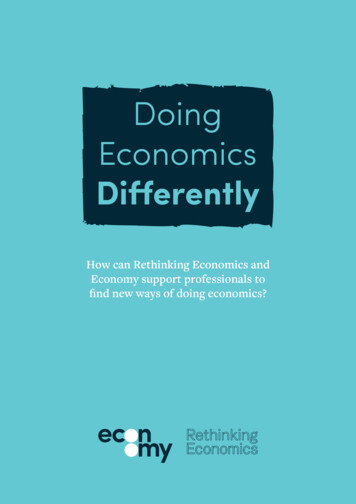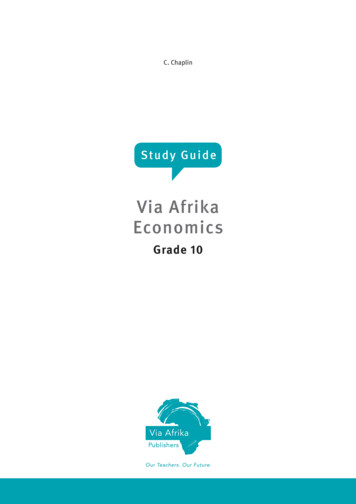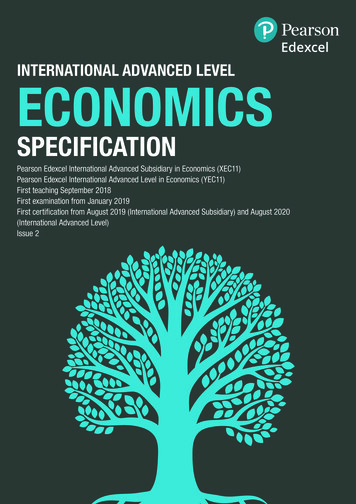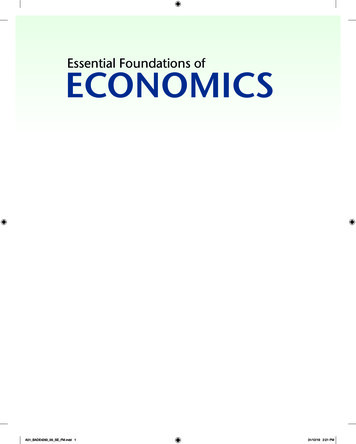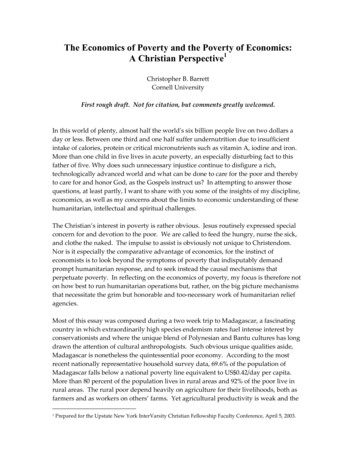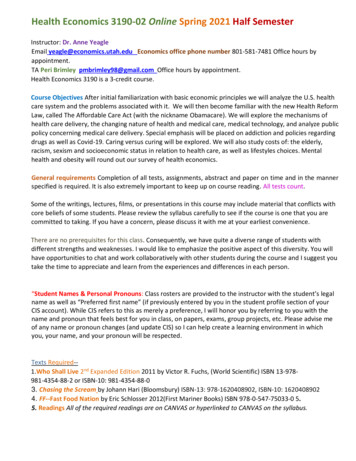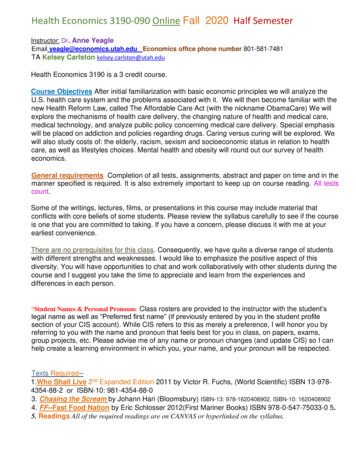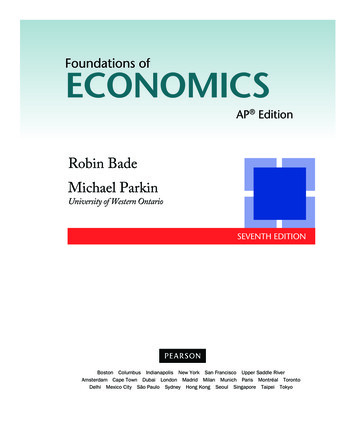
Transcription
Foundations ofEconomicsAP EditionRobin BadeMichael ParkinUniversity of Western OntarioSeventh EditionBoston Columbus Indianapolis New York San Francisco Upper Saddle RiverAmsterdam Cape Town Dubai London Madrid Milan Munich Paris Montréal TorontoDelhi Mexico City São Paulo Sydney Hong Kong Seoul Singapore Taipei TokyoA03 BADE2701 07 AP FM.indd 11/3/14 1:00 PM
To Erin, Tessa, Jack, Abby, and SophieEditor in Chief: Donna BattistaExecutive Acquisitions Editor: Adrienne D’AmbrosioEditorial Project Manager: Sarah DumouchelleEditorial Assistant: Elissa Senra-SargentExecutive Marketing Manager: Lori DeShazoManaging Editor: Jeff HolcombProduction Project Manager: Nancy FreihoferMedia Publisher: Denise ClintonContent Product Manager: Noel LotzSenior Media Producer: Melissa HonigImage Permission Manager: Rachel YoudelmanPhoto Researcher: Joseph SongcoArt Director, Cover: Jonathan BoylanCover Image: Rich Carey/ShutterstockCopyeditor: Catherine BaumTechnical Illustrator: Richard ParkinProject Management, Page Makeup, Design: IntegraPrinter/Binder: Courier/KendallvilleCover Printer: Courier/KendallvilleText Font: 10/12, Palatino-RomanCredits and acknowledgments borrowed from other sources and reproduced, with permission, in thistextbook appear on the appropriate page within text and on pages C-1–C-2.FRED is a registered trademark and the FRED logo and ST.LOUIS FED are trademarks of theFederal Reserve Bank of St. Louis, http://researchstlouisfed.org/fred2/AP is a trademark registered and/or owned by the College Board, which was not involved in theproduction of, and does not endorse, this product.Copyright 2015, 2013, 2011 by Pearson Education, Inc. All rights reserved. Manufactured in theUnited States of America. This publication is protected by Copyright, and permission should be obtained from the publisher prior to any prohibited reproduction, storage in a retrieval system, or transmission in any form or by any means, electronic, mechanical, photocopying, recording, or l ikewise.To obtain permission(s) to use material from this work, please submit a written request to PearsonEducation, Inc., Permissions Department, One Lake Street, Upper Saddle River, New Jersey 07458, oryou may fax your request to 201-236-3290.Many of the designations by manufacturers and sellers to distinguish their products are claimed astrademarks. Where those designations appear in this book, and the publisher was aware of a trademark claim, the designations have been printed in initial caps or all caps.10 9 8 7 6 5 4 3 2 1AP Edition School BindingISBN 10:0-13-381270-7ISBN 13: 978-0-13-381270-1A03 BADE2701 07 AP FM.indd 21/3/14 1:00 PM
About the AuthorsRobin Bade was an undergraduate at the University of Queensland,Australia, where she earned degrees in mathematics and economics. After aspell teaching high school math and physics, she enrolled in the Ph.D. programat the Australian National University, from which she graduated in 1970. Shehas held faculty appointments at the University of Edinburgh in Scotland, atBond University in Australia, and at the Universities of Manitoba, Toronto, andWestern Ontario in Canada. Her research on international capital flows appears inthe International Economic Review and the Economic Record.Robin first taught the principles of economics course in 1970 and has taughtit (alongside intermediate macroeconomics and international trade and finance)most years since then. She developed many of the ideas found in this text whileconducting tutorials with her students at the University of Western Ontario.Michael Parkinstudied economics in England and began his university teaching career immediately after graduating with a B.A. from the Universityof Leicester. He learned the subject on the job at the University of Essex, England’smost exciting new university of the 1960s, and at the age of 30 became one ofthe youngest full professors. He is a past president of the Canadian EconomicsAssociation and has served on the editorial boards of the American Economic Reviewand the Journal of Monetary Economics. His research on macroeconomics, monetaryeconomics, and international economics has resulted in more than 160 publications in journals and edited volumes, including the American Economic Review, theJournal of Political Economy, the Review of Economic Studies, the Journal of MonetaryEconomics, and the Journal of Money, Credit, and Banking. He is author of the bestselling textbook, Economics (Addison-Wesley), now in its Eleventh Edition.Robin and Michael are a wife-and-husband team. Their most notable jointr esearch created the Bade-Parkin Index of central bank independence andspawned a vast amount of research on that topic. They don’t claim credit for theindependence of the new European Central Bank, but its constitution and themovement toward greater independence of central banks around the world wereaided by their pioneering work. Their joint textbooks include Macroeconomics(Prentice-Hall), Modern Macroeconomics (Pearson Education Canada), andEconomics: Canada in the Global Environment, the Canadian adaptation of Parkin,Economics (Addison-Wesley). They are dedicated to the challenge of explainingeconomics ever more clearly to a growing body of students.Music, the theater, art, walking on the beach, and five grandchildren provides their relaxation and fun.iiiA03 BADE2701 07 AP FM.indd 31/3/14 1:00 PM
EconomicsBrief ContentsPart 1 Introduction1 Getting Started, 12 The U.S. and Global Economies, 313 The Economic Problem, 574 Demand and Supply, 81Part 2A Closer Look at Markets5 Elasticities of Demand and Supply, 1116 Efficiency and Fairness of Markets, 137Part 3 How Governments Influence the Economy7 Government Actions in Markets, 1678 Taxes, 1899 Global Markets in Action, 213Part 4 Market Failure and Public Policy10 Externalities, 24111 Public Goods and Common Resources, 26512 Markets with Private Information 291Part 5A Closer Look at Decision Makers13 Consumer Choice and Demand, 31514 Production and Cost, 343Part 6Prices, Profits, and Industry Performance15 Perfect Competition, 37116 Monopoly, 39917 Monopolistic Competition, 43118 Oligopoly, 455Part 7 Incomes and Inequality19 Markets for Factors of Production, 48320 Economic Inequality, 507ivA03 BADE2701 07 AP FM.indd 41/3/14 1:00 PM
Brief ContentsvPart 8 Monitoring the Macroeconomy21 GDP: A Measure of Total Production andIncome, 53322 Jobs and Unemployment, 56323 The CPI and the Cost of Living, 585Part 9 The Real Economy24 Potential GDP and the Natural UnemploymentRate, 60925 Economic Growth, 63326 Finance, Saving, and Investment, 659Part 10 The Money Economy27 The Monetary System, 68528 Money, Interest, and Inflation, 715Part 11 Economic Fluctuations29 Aggregate Supply and Aggregate Demand, 74330 Aggregate Expenditure Multiplier, 76931 The Short-Run Policy Tradeoff, 795Part 12 Macroeconomic Policy32 Fiscal Policy, 81733 Monetary Policy, 84334 International edits C-1A03 BADE2701 07 AP FM.indd 51/3/14 1:00 PM
ContentsP a rt 1 I n t r o d u c t i onChapter1.11ChapterThe U.S. and Global Economies 31Chapter Checklist 1Chapter Checklist 31Definition and Questions 22.1Scarcity, 2Economics Defined, 2What, How, and For Whom? 3Can the Pursuit of Self-Interest Be in the Social Interest? 4Checkpoint 1.1 71.22Getting Started 1The Economic Way of Thinking 8Economic Ideas, 8A Choice Is a Tradeoff, 8Cost: What You Must Give Up, 8Benefit: What You Gain, 9Rational Choice, 9How Much? Choosing at the Margin, 10Choices Respond to Incentives, 11Economics as Social Science, 12Economics as Policy Tool, 14Checkpoint 1.2 16Chapter summary 17Chapter Checkpoint 18Appendix : Making and Using Graphs 21Basic Idea 21Interpreting Data Graphs, 22Interpreting Graphs Used in Economic Models, 24The Slope of a Relationship, 27Relationships Among More Than Two Variables, 28What, How, and For Whom? 32What Do We Produce? 32How Do We Produce? 34For Whom Do We Produce? 37Checkpoint 2.1 382.2The Global Economy 39The People, 39The Economies, 39What in the Global Economy? 40How in the Global Economy? 42For Whom in the Global Economy? 42Checkpoint 2.2 452.3The Circular Flows 46Households and Firms, 46Markets, 46Real Flows and Money Flows, 46Governments, 48Governments in the Circular Flow, 49Circular Flows in the Global Economy, 50Checkpoint 2.3 52Chapter summary 53Chapter Checkpoint 54 Eye on the U.S. EconomyWhat We Produce, 33 EYE on the PASTAppendix Checkpoint 30Changes in What We Produce, 34 Eye on the Past EYE on the U.S. ECONOMYAdam Smith and the Birth of Economics as a SocialScience, 13Changes in How We Produce in the InformationEconomy, 36 Eye on the Benefit and cost of school EYE on the DreamlinerDid You Make the Right Decision? 15Who Makes the Dreamliner? 41viA03 BADE2701 07 AP FM.indd 61/3/14 1:00 PM
contents EYE on the GLOBAL ECONOMY EYE on the U.S. ECONOMYDifferences in How We Produce, 43No One Knows How to Make a Pencil, 71 EYE on YOUR LIFE EYE on YOUR LIFEThe U.S. and Global Economies in Your Life, 45Your Comparative Advantage, 74vii EYE on the PASTGrowing Government, 50Chapter EYE on the GLOBAL ECONOMY4Demand and Supply 81The Ups and Downs in International Trade, 52Chapter Checklist 81Chapter3The Economic Problem 57Chapter Checklist 573.1Production Possibilities 58Production Possibilities Frontier, 58Checkpoint 3.1 633.2 Opportunity Cost 64The Opportunity Cost of a Cell Phone, 64Opportunity Cost and the Slope of the PPF, 65Opportunity Cost Is a Ratio, 65Increasing Opportunity Costs Are Everywhere, 66Your Increasing Opportunity Cost, 66Checkpoint 3.2 673.3Economic Growth 68Checkpoint 3.3 703.4 Specialization and Trade 71Absolute Advantage and Comparative Advantage, 71Comparative Advantage: An Example, 72Achieving Gains from Trade, 74Checkpoint 3.4 76Chapter summary 77Chapter Checkpoint 78 EYE on YOUR LIFEYour Production Possibilities Frontier, 62Competitive Markets 824.1Demand 83The Law of Demand, 83Demand Schedule and Demand Curve, 83Individual Demand and Market Demand, 85Changes in Demand, 86Change in Quantity Demanded Versus Change inDemand, 88Checkpoint 4.1 894.2 Supply 90The Law of Supply, 90Supply Schedule and Supply Curve, 90Individual Supply and Market Supply, 92Changes in Supply, 93Change in Quantity Supplied Versus Change inSupply, 95Checkpoint 4.2 974.3 Market Equilibrium 98Price: A Market’s Automatic Regulator, 98Predicting Price Changes: Three Questions, 99Effects of Changes in Demand, 100Effects of Changes in Supply, 102Effects of Changes in Both Demand and Supply, 104Checkpoint 4.3 106Chapter summary 107Chapter Checkpoint 108 EYE on the ENVIRONMENT EYE on YOUR LIFEIs Wind Power Free? 66Understanding and Using Demand and Supply, 96 EYE on the U.S. ECONOMY EYE on TuitionExpanding Our Production Possibilities, 69Why Does Tuition Keep Rising? 101 EYE on the GLOBAL ECONOMY EYE on the GLOBAL ECONOMYHong Kong’s Rapid Economic Growth, 70The Market for Solar Panels, 103A03 BADE2701 07 AP FM.indd 71/3/14 1:00 PM
viii contentsP a rt 2 A C lo s e r L o o k at Mar ket sChapter5.15ChapterElasticities of Demandand Supply 111Efficiency and Fairnessof Markets 137Chapter Checklist 111Chapter Checklist 137The Price Elasticity of Demand 112Percentage Change in Price, 112Percentage Change in Quantity Demanded, 113Comparing the Percentage Changes in Priceand Quantity, 113Elastic and Inelastic Demand, 114Influences on the Price Elasticity of Demand, 114Computing the Price Elasticity of Demand, 116Interpreting the Price Elasticity of DemandNumber, 117Elasticity Along a Linear DemandCurve, 118Total Revenue and the Price Elasticity ofDemand, 120Applications of the Price Elasticity of Demand, 1226.1Checkpoint 6.1 1456.2Checkpoint 6.2 1486.3 Cost, Price, and Producer Surplus 149Supply and Marginal Cost, 149Producer Surplus, 150Checkpoint 6.3 1516.4Checkpoint 5.2 128Checkpoint 5.3 132Chapter summary 133Chapter Checkpoint 134 EYE on the GLOBAL ECONOMYPrice Elasticities of Demand, 119 EYE on the Price of GasolineAre Markets Efficient? 152Marginal Benefit Equals Marginal Cost, 152Total Surplus Is Maximized, 153The Invisible Hand, 153Market Failure, 155Sources of Market Failure, 156Alternatives to the Market, 157Elastic and Inelastic Supply, 124Influences on the Price Elasticity of Supply, 124Computing the Price Elasticity of Supply, 126Cross Elasticity of Demand, 129Income Elasticity of Demand, 130Value, Price, and Consumer Surplus 146Demand and Marginal Benefit, 146Consumer Surplus, 147The Price Elasticity of Supply 1245.3 Cross Elasticity and Income Elasticity 129Allocation Methods and efficiency 138Resource Allocation Methods, 138Using Resources Efficiently, 141Checkpoint 5.1 1235.26Checkpoint 6.4 1586.5Are Markets Fair? 159It’s Not Fair If the Rules Aren’t Fair, 159It’s Not Fair If the Result Isn’t Fair, 159Compromise, 161Checkpoint 6.5 162Chapter summary 163Chapter Checkpoint 164 EYE on the U.S. ECONOMYThe Invisible Hand and e-Commerce, 154What Do You Do When the Price of GasolineRises? 121 EYE on Price Gouging EYE on YOUR LIFE EYE on YOUR LIFEYour Price Elasticities of Demand, 131A03 BADE2701 07 AP FM.indd 8Should Price Gouging Be Illegal? 160Allocation Methods, Efficiency, and Fairness, 1611/3/14 1:00 PM
contentsixP a rt 3 H o w G o v e r nment s Infl uence t he Econom yChapter7Incidence, Inefficiency, and the Elasticityof Supply, 194Government Actionsin Markets 167Chapter Checklist 1677.1Checkpoint 7.1 173Price Floors 174The Minimum Wage, 175Is the Minimum Wage Efficient? 178Is the Minimum Wage Fair? 179If the Minimum Wage Is So Bad, Why Do WeHave It? 179Checkpoint 7.2 1807.38.2 Income Tax and Social Security Tax 196The Personal Income Tax, 196The Effects of the Income Tax, 198The Social Security Tax, 202Price Ceilings 168A Rent Ceiling, 168Are Rent Ceilings Efficient? 171Are Rent Ceilings Fair? 172If Rent Ceilings Are So Bad, Why Do WeHave Them? 1727.2Checkpoint 8.1 195Price Supports in Agriculture 181How Governments Intervene in Markets for FarmProducts, 181Price Support: An Illustration, 181Checkpoint 7.3 184Chapter summary 185Checkpoint 8.2 2058.3Fairness and the Big Tradeoff 206The Benefits Principle, 206The Ability-to-Pay Principle, 206The Marriage Tax Problem, 207The Big Tradeoff, 208Checkpoint 8.3 208Chapter summary 209Chapter Checkpoint 210 EYE on the U.S. ECONOMYTaxes in the United States Today, 196 EYE on CongressDoes Congress Decide Who Pays the Taxes? 200 EYE on the PASTThe Origins and History of the U.S. Income Tax, 204 EYE on YOUR LIFETax Freedom Day, 204Chapter Checkpoint 186 EYE on the U.S. ECONOMY9Global Markets in Action 213 EYE on Price RegulationChapter Checklist 213Can the President Repeal the Laws of Supply andDemand? 179 EYE on YOUR LIFEPrice Ceilings and Price Floors, 183Chapter8Taxes 189Chapter Checklist 1898.1ChapterThe Federal Minimum Wage, 177Taxes on Buyers and Sellers 190Tax Incidence, 190Taxes and Efficiency, 191Incidence, Inefficiency, and Elasticity, 192Incidence, Inefficiency, and the Elasticity of Demand, 193A03 BADE2701 07 AP FM.indd 99.1 How Global Markets Work 214International Trade Today, 214What Drives International Trade? 214Why the United States Imports T-Shirts, 216Why the United States Exports Airplanes, 217Checkpoint 9.1 2189.2 Winners, Losers, and Net GainsFrom Trade 219Gains and Losses from Imports, 220Gains and Losses from Exports, 221Checkpoint 9.2 2229.3 International Trade Restrictions 223Tariffs, 223Import Quotas, 2271/3/14 1:00 PM
x contents9.4Other Import Barriers, 229Export Subsidies, 229 EYE on the U.S. ECONOMYCheckpoint 9.3 230 EYE on GlobalizationThe Case Against Protection 231Who Wins and Who Loses from Globalization? 219Three Traditional Arguments for Protection, 231Four Newer Arguments for Protection, 233Why Is International Trade Restricted? 234 EYE on the PASTThe History of U.S. Tariffs, 223Checkpoint 9.4 236International Trade, 235U.S. Exports and Imports, 215 EYE on YOUR LIFEChapter summary 237Chapter Checkpoint 238P a rt 4 Ma r k e t F a il ur e A ND P UBLIC P OLICYChapter10Externalities 241Chapter Checklist 241Externalities in Our Daily Lives 242Negative Production Externalities, 242Positive Production Externalities, 242Negative Consumption Externalities, 243Positive Consumption Externalities, 24310.1 Negative Externalities: Pollution 244Private Costs and Social Costs, 244Production and Pollution: How Much? 246Establish Property Rights, 247Mandate Clean Technology, 249Tax or Cap and Price Pollution, 249Chapter11Public Goods and CommonResources 265Chapter Checklist 26511.1 Classifying Goods and 266A Fourfold Classification, 266Checkpoint 11.1 26811.2 Public Goods and the Free-RiderProblem 269Private Benefits and Social Benefits, 254Government Actions in the Face of ExternalBenefits, 256The Free-Rider Problem, 269The Marginal Benefit from a Public Good, 270The Marginal Cost of a Public Good, 270The Efficient Quantity of a Public Good, 272Private Provision: Underproduction, 272Public Provision: Efficient Production, 273Public Provision: Overproduction, 274Why Government Is Large and Growing, 275Checkpoint 10.2 260Checkpoint 11.2 277Checkpoint 10.1 25310.2 Positive Externalities: Education 254Chapter summary 261Chapter Checkpoint 262 EYE on the U.S. ECONOMYU.S. Air Pollution Trends, 251 EYE on Climate Change11.3 Common Resources 278Unsustainable Use of a CommonResource, 278Inefficient Use of a Common Resource, 279Using the Commons Efficiently, 282Checkpoint 11.3 286How Can We Limit Climate Change? 252Chapter summary 287 EYE on the U.S. ECONOMYChapter Checkpoint 288Education Quality: Charter Schools and Vouchers, 259 EYE on YOUR LIFEExternalities in Your Life, 259A03 BADE2701 07 AP FM.indd 10 EYE on the PASTIs a Lighthouse a Public Good? 2681/3/14 1:00 PM
contents EYE on the U.S. InfrastructureShould America Build a High-Speed Rail Network likeEurope’s? 276Asymmetric Information in Insurance, 300Screening in Insurance Markets, 302Separating Equilibrium with Screening, 302 EYE on YOUR LIFECheckpoint 12.2 304A Student’s Free-Rider Problem, 276 EYE on the PASTThe Commons of England’s Middle Ages, 278 EYE on the GLOBAL ECONOMYThe North Atlantic Cod Tragedy of the Commons, 280 EYE on the GLOBAL ECONOMYITQs Work, 285xi12.3 Health-Care Markets 305Economic Problems in Health-Care Markets, 305Missing Insurance Market, 306Public-Health Externalities, 306Health-Care Systems in Other Countries, 306A Reform Idea, 309Checkpoint 12.3 310Chapter summary 311Chapter12Markets with PrivateInformation 291Chapter Checklist 29112.1 The Lemons Problem and its Solution 292Chapter Checkpoint 312 EYE on the Market for Used CarsHow Do You Avoid Buying a Lemon? 296 EYE on the U.S. ECONOMYInsurance in the United States, 299 EYE on the U.S. ECONOMYA Market for Used Cars with a Lemons Problem, 292A Used-Car Market with Dealers’ Warranties, 296Health Care in the United States: A Snapshot, 307Checkpoint 12.1 298Health-Care Expenditures and HealthOutcomes, 30812.2 Information Problems in InsuranceMarkets 299Insurance Markets, 299 EYE on the GLOBAL ECONOMY EYE on YOUR LIFESignaling Your Ability, 309P a rt 5 A C lo s e r L ook at Deci si on Maker sChapter13Consumer Choiceand Demand 315Chapter Checklist 31513.1 Consumption Possibilities 316The Budget Line, 316A Change in the Budget, 317Changes in Prices, 318Prices and the Slope of the Budget Line, 319Checkpoint 13.1 32113.2 Marginal Utility Theory 322Total Utility, 322Marginal Utility, 322Graphing Tina’s Utility Schedules, 324Maximizing Total Utility, 324Finding an Individual Demand Curve, 32613.3 Efficiency, Price, and Value 329Consumer Efficiency, 329The Paradox of Value, 329Checkpoint 13.3 332Chapter summary 333Chapter Checkpoint 334Appendix: Indifference Curves 337An Indifference Curve, 337Marginal Rate of Substitution, 338Consumer Equilibrium, 339Deriving the Demand Curve, 340Appendix Checkpoint 342 EYE on the U.S. ECONOMYRelative Prices on the Move, 320Checkpoint 13.2 328A03 BADE2701 07 AP FM.indd 111/3/14 1:00 PM
xii contents EYE on the PASTAverage Product, 352Jeremy Bentham, William Stanley Jevons, and the Birthof Utility, 323Checkpoint 14.2 354 EYE on Song DownloadsHow Much Would You Pay for a Song? 330 EYE on YOUR LIFEDo You Maximize Your Utility? 332Chapter14Production and Cost 343Chapter Checklist 34314.1 Economic Cost and Profit 344The Firm’s Goal, 344Accounting Cost and Profit, 344Opportunity Cost, 344Economic Profit, 345Checkpoint 14.1 347Short Run and Long Run 34814.2 Short-Run Production 349Total Product, 349Marginal Product, 35014.3 Short-Run Cost 355Total Cost, 355Marginal Cost, 356Average Cost, 357Why the Average Total Cost Curve IsU-Shaped, 359Cost Curves and Product Curves, 360Shifts in the Cost Curves, 360Checkpoint 14.3 36214.4 Long-Run Cost 363Plant Size and Cost, 363The Long-Run Average Cost Curve, 364Checkpoint 14.4 366Chapter summary 367Chapter Checkpoint 368 EYE on YOUR LIFEYour Average and Marginal Grades, 353 EYE on Retailers’ CostsWhich Store Has the Lower Costs: Wal-Martor 7-Eleven? 365P a rt 6 P r ic e s , P r o f i t s, and Ind ust r y P er for manceChapter15Perfect Competition 371Chapter Checklist 371Market Types 372Perfect Competition, 372Other Market Types, 37215.1 A Firm’s Profit-Maximizing Choices 373Price Taker, 373Revenue Concepts, 373Profit-Maximizing Output, 374Marginal Analysis and the Supply Decision, 376Temporary Shutdown Decision, 377The Firm’s Short-Run Supply Curve, 378Checkpoint 15.1 38015.2 Output, Price, and Profit in theShort run 381Market Supply in the Short Run, 381Short-Run Equilibrium in Normal Times, 382A03 BADE2701 07 AP FM.indd 12Short-Run Equilibrium in Good Times, 383Short-Run Equilibrium in Bad Times, 384Checkpoint 15.2 38515.3 Output, Price, and Profit in theLong Run 386Entry and Exit, 387The Effects of Exit, 388Change in Demand, 389Technological Change, 389Is Perfect Competition Efficient? 392Is Perfect Competition Fair? 393Checkpoint 15.3 394Chapter summary 395Chapter Checkpoint 396 EYE on Record StoresWhere Have All the Record Stores Gone? 390 EYE on YOUR LIFEThe Perfect Competition that You Encounter, 3931/3/14 1:00 PM
contentsChapter16Monopoly 399Chapter Checklist 39916.1 Monopoly and How it Arises 400How Monopoly Arises, 400Monopoly Price-Setting Strategies, 402Checkpoint 16.1 40316.2 Single-Price Monopoly 404Price and Marginal Revenue, 404Marginal Revenue and Elasticity, 405Output and Price Decision, 406Checkpoint 16.2 40816.3 Monopoly and Competition Compared 409Output and Price, 409Is Monopoly Efficient? 410Is Monopoly Fair? 411Rent Seeking, 411Checkpoint 16.3 41316.4 Price Discrimination 414Price Discrimination and Consumer Surplus, 414Profiting by Price Discriminating, 415Perfect Price Discrimination, 416Price Discrimination and Efficiency, 418Checkpoint 16.4 41916.5 Monopoly Regulation 420Efficient Regulation of a Natural Monopoly, 420Second-Best Regulation of a Natural Monopoly, 421Competing on Quality, Price, and Marketing, 432Entry and Exit, 433Identifying Monopolistic Competition, 433Checkpoint 17.1 43717.2 Output and Price Decisions 438The Firm’s Profit-Maximizing Decision, 438Profit Maximizing Might Be Loss Minimizing, 439Long Run: Zero Economic Profit, 440Monopolistic Competition and PerfectCompetition, 441Is Monopolistic Competition Efficient? 442Checkpoint 17.2 44317.3 Product Development and Marketing 444Product Development, 444Marketing, 445Using Advertising to Signal Quality, 448Brand Names, 449Efficiency of Advertising and Brand Names, 449Checkpoint 17.3 450Chapter summary 451Chapter Checkpoint 452 EYE on the U.S. ECONOMYExamples of Monopolistic Competition, 436 EYE on cell phonesWhich Cell Phone? 445 EYE on YOUR LIFESome Selling Costs You Pay, 448Checkpoint 16.5 426Chapter summary 427Chapter Checkpoint 428 EYE on the U.S. ECONOMYAirline Price Discrimination, 418 EYE on MicrosoftAre Microsoft’s Prices Too High? 423 EYE on YOUR LIFEMonopoly in Your Everyday er Checklist 45518.1 What is Oligopoly? 456Small Number of Firms, 456Barriers to Entry, 456Identifying Oligopoly, 458Checkpoint 18.1 45918.2 The Oligopolists’ Dilemma 460Chapter17Monopolistic Competition 431Chapter Checklist 43117.1 What is Monopolistic Competition? 432Large Number of Firms, 432Product Differentiation, 432A03 BADE2701 07 AP FM.indd 13Monopoly Outcome, 460Perfect Competition Outcome, 461Other Possible Cartel Breakdowns, 461The Oligopoly Cartel Dilemma, 462Checkpoint 18.2 46418.3 Game Theory 465What Is a Game? 465The Prisoners’ Dilemma, 4651/3/14 1:00 PM
xiv contentsThe Duopolists’ Dilemma, 467The Payoff Matrix, 467Advertising and Research Games inOligopoly, 468Repeated Games, 470Is Oligopoly Efficient? 471Chapter summary 479Chapter Checkpoint 480 EYE on the U.S. ECONOMYExamples of Oligopoly, 458 EYE on the GLOBAL ECONOMYCheckpoint 18.3 472The OPEC Global Oil Cartel, 46318.4 Antitrust Law 473 EYE on YOUR LIFEThe Antitrust Laws, 473Three Antitrust Policy Debates, 473Recent Antitrust Showcase: The United States VersusMicrosoft, 475Merger Rules, 476A Game You Might Play, 470 EYE on the Cell-Phone OligopolyIs Two Too Few? 471 EYE on the U.S. ECONOMYNo Cell-Phone Service Merger, 477Checkpoint 18.4 478P a rt 7 I n c o m e s a n d Inequal i t yChapter19Markets for Factorsof Production 483Chapter Checklist 483The Anatomy of Factor Markets 48419.1 The Demand for a Factor of Production 485Value of Marginal Product, 485A Firm’s Demand for Labor, 486A Firm’s Demand for Labor Curve, 487Changes in the Demand for Labor, 488Checkpoint 19.1 48919.2 Labor Markets 490The Supply of Labor, 490Influences on the Supply of Labor, 491Competitive Labor Market Equilibrium, 492Labor Unions, 494Checkpoint 19.2 49619.3 Capital and Natural Resource Markets 497Capital Markets, 497Land Markets, 498Nonrenewable Natural Resource Markets, 499Checkpoint 19.3 502Chapter summary 503 EYE on YOUR LIFEJob Choice and Income Prospects, 499 EYE on the GLOBAL ECONOMYOil and Metal Prices, 501Chapter20Economic Inequality 507Chapter Checklist 50720.1 Measuring Economic Inequality 508Lorenz Curves, 509Inequality over Time, 510Economic Mobility, 510Poverty, 513Checkpoint 20.1 51520.2 How Economic Inequality Arises 516Human Capital, 516Discrimination, 519Financial and Physical Capital, 520Entrepreneurial Ability, 520Personal and Family Characteristics, 520Checkpoint 20.2 52120.3 Income Redistribution 522 EYE on the coachHow Governments Redistribute Income, 522The Scale of Income Redistribution, 523Why We Redistribute Income, 525The Major Welfare Challenge, 526Why Is a Coach Worth 5.5 Million? 493Checkpoint 20.3 528Chapter Checkpoint 504A03 BADE2701 07 AP FM.indd 141/3/14 1:00 PM
contentsChapter summary 529Chapter Checkpoint 530 EYE on the GLOBAL ECONOMYGlobal Inequality, 511 EYE on Inequalityxv EYE on the U.S. ECONOMYDoes Education Pay? 518 EYE on the U.S. ECONOMYSex and Race Earnings Differences, 519 EYE on YOUR LIFEWhat You Pay and Gain Through Redistribution, 527Who Are the Rich and the Poor? 512P a rt 8 M o n i t o r ing t he Macr oeconomyChapter21GDP: A Measure of TotalProduction and Income 533Chapter Checklist 53321.1 GDP, Income, and Expenditure 534GDP Defined, 534Circular Flows in the U.S. Economy, 535Expenditure Equals Income, 536 EYE on the Booms and BustsHow Do We Track the Booms and Busts of ourEconomy? 550 EYE on YOUR LIFEMaking GDP Personal, 552 EYE on the GLOBAL ECONOMYWhich Country Has the Highest Standard ofLiving? 553Checkpoint 21.1 53821.2 Measuring U.S. GDP 539The Expenditure Approach, 539The Income Approach, 541GDP and Related Measures of Productionand Income, 543Real GDP and Nominal GDP, 544Calculating Real GDP, 544Using the Real GDP Numbers, 545Checkpoint 21.2 54621.3 The Uses and Limitations of Real GDP 547The Standard of Living Over Time, 547Tracking the Course of the Business Cycle, 548The Standard of Living Among Countries, 550Goods and Services Omitted from GDP, 551Other Influences on the Standard of Living, 552Checkpoint 21.3 554Chapter summary 555Chapter Checkpoint 556Appendix: Measuring Real GDP 559The Problem With Base-Year Prices, 559Value Production in the Prices of Adjacent Years, 559Appendix Checkpoint 562 EYE on the U.S. ECONOMYIs a Computer Program an Intermediate Good or aFinal Good? 540A03 BADE2701 07 AP FM.indd 15Chapter22Jobs and Unemployment 563Chapter Checklist 56322.1 Labor Market Indicators 564Current Population Survey, 564Population Survey Criteria, 564Two Main Labor Market Indicators, 565Alternative Measures of Unemployment, 566Checkpoint 22.1 56822.2 Labor Market Trends and Fluctuations 569Unemployment Rate, 569The Participation Rate, 570Alternative Measures of Unemployment, 572A Closer Look at Part-Time Employment, 573Checkpoint 22.2 57422.3 Unemployment and Full Employment 575Frictional Unemployment, 575Structural Unemployment, 575Cyclical Unemployment, 576“Natural” Unemployment, 576Unemployment and Real GDP, 577Checkpoint 22.3 580Chapter summary 581Chapter Checkpoint 5821/3/14 1:00 PM
xvi contents EYE on the U.S. ECONOMYThe Current Population Survey, 567 EYE on the GLOBAL ECONOMYUnemployment Around the World, 570 EYE on the GLOBAL ECONOMYWomen in the Labor Force, 571 EYE on the UnemployedHow Long Does it Take to Fi
Foundations of Economics Seventh edition Boston Columbus Indianapolis New York San Francisco Upper Saddle River Amsterdam Cape Town Dubai London Madrid Milan Munich Paris Montréal Toronto Delhi Mexico City São Paulo Sydney Hong Kong Seoul Singapore Taipei Tokyo AP edition A03_BADE2701_07_AP_FM.indd 1 1/3/14 1:00 PM




